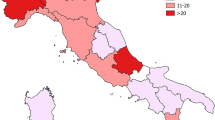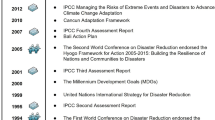Abstract
In recent decades, risk management is significant to mitigate the severe status caused by droughts. As one of the primary components in risk analysis, drought hazard analysis is basic but important. In this paper, the framework of drought risk analysis and the methodology for drought hazard analysis are presented, and Huaibei Plain of China is chosen as the study area. The whole study region is divided into three parts (northern, central, and southern) by geographical factors, and a developed index named drought comprehensive Z index (DCZI) containing hydrological and meteorological factors is employed for drought hazard analysis in each area. By comparison, it implicates that DCZI is applicable for Huaibei Plain and indicates drought extent more objectively. Moreover, the results of drought hazard analysis reflect that the northern area is affected by droughts more seriously. As for the whole region, there is a great probability of severe drought. Finally, some policy recommendations on drought management are also made.














Similar content being viewed by others
References
American Meteorological Society (2004) Statement on meteorological drought. Bull Am Meteorol Soc 85:771–773
Blaikie P, Cannon T, Davis I, Wisner B (1994) At risk: natural hazards, people’s vulnerability, and disasters. Routledge, London
Bonaccorso B, Cancelliere A, Rossi G (2003) An analytical formulation of return period of drought severity. Stoch Environ Res Risk Assess 17:157–174
Calow R, Robins N, Macdonald A, Nicol A (1999) Planning for groundwater drought in Africa. In: Proceedings of the international conference on integrated drought management: lessons for sub-Saharan Africa. IHP-V, Technical Documents in Hydrology, 35:255–270
Cancelliere A, Salas JD (2010) Drought probabilities and return period for annual streamflows series. J Hydrol 391:77–89
Chang TJ, Teoh CB (1995) Use of the Kriging method for studying characteristics of groundwater droughts. J Am Water Resour As 31:1001–1007
China Meteorological Administration (2006) Classification of meteorological drought. Standards Press of China, Beijing (in Chinese)
Eltahir EAB, Yeh PJF (1999) On the asymmetric response of aquifer water level to floods and droughts in Illinois. Water Resour Res 35:1199–1217
Fleig AK, Tallaksen LM, Hisdal H, Demuth S (2006) A global evaluation of streamflow drought characteristics. Hydrol Earth Syst Sci 10:535–552
González J, Valdés JB (2003) Bivariate drought recurrence analysis using tree ring reconstructions. J Hydrol Eng 8:247–258
Hao L, Zhang XY, Liu SD (2012) Risk assessment to China’s agricultural drought disaster in county unit. Nat Hazards 61:785–801
Hu AY, Gao J, He Y, Yu YF (2002) Soil water and salt balance model for irrigation district in arid and inland region. Adv Water Sci 13:726–729 (in Chinese)
Hu WW, Wang SC, Wang GX, Deng W (2009) Study on the groundwater dynamic of the Huaibei Alluvial Plain in Anhui province. J Nat Resour 24:1893–1901 (in Chinese)
IPCC (2007) Climate change: impacts, adaptation and vulnerability. Contribution of working group II to the fourth assessment report of the intergovernmental panel on climate change. Cambridge University Press, Cambridge
Ju XS, Yang XW, Chen LJ, Wang YM (1997) Research on determination of indices and division of regional flood/drought grades in China. Q J Appl Meteorol 8:26–33 (in Chinese)
Kendall MG, Stuart A (1977) The Advanced theory of statistics. Charles Griffin, London
Kim T, Valdes JB, Aparicio J (2002) Frequency and spatial characteristics of droughts in the Conchos River Basin, Mexico. Water Int 27:420–430
Kim S, Kim B, Ahn TJ, Kim HS (2011) Spatio-temporal characterization of Korean drought using severity-area-duration curve analysis. Water Environ J 25:22–30
Liu CL, Zhang Q, Singh VP, Cui Y (2011) Copula-based evaluations of drought variations in Guangdong, South China. Nat Hazards 59:1533–1546
Liu XJ, Zhang JQ, Ma DL et al (2013) Dynamic risk assessment of drought disaster for maize based on integrating multi-sources data in the region of the northwest of Liaoning Province, China. Nat Hazards 65:1393–1409
Mathier L, Perreault L, Bobée B, Ashkar F (1992) The use of geometric and gamma-related distributions for frequency analysis of water deficit. Stoch Hydrol Hydraul 6:239–254
McKee TB, Doesken NJ, Kleist J (1993) The relationship of drought frequency and duration to time scales. Preprints eighth conference on applied climatology Anaheim CA. Am Meteor Soc, pp 179–184
Ministry of water resources of China (2011) National anti-drought plan (in Chinese)
Mirakbari M, Ganji A, Fallah SR (2010) Regional bivariate frequency analysis of meteorological droughts. J Hydrol Eng 15:985–1000
Mishra AK, Desai VR (2005) Spatial and temporal drought analysis in the Kansabati river basin, India. Int J River Basin Manag 3:31–41
Mishra AK, Singh VP (2011) Drought modeling—a review. J Hydrol 403:157–175
Mishra AK, Singh VP, Desai VR (2009) Drought characterization: a probabilistic approach. Stoch Environ Res Risk Assess 23:41–55
Nelson RB (2006) An introduction to copulas. Springer, New York
Palmer WC (1965) Meteorologic drought. US Department of Commerce, Weather Bureau, Research Paper No. 45, Washington DC
Palmer WC (1968) Keeping track of crop moisture conditions, nationwide: the new crop moisture index. Weatherwise 21:156–161
Piao SL, Ciais P, Huang Y et al (2010) The impacts of climate change on water resources and agriculture in China. Nature 467:43–51
Salas JD, Fu CJ, Cancelliere A et al (2005) Characterizing the severity and risk of drought in the Poudre River, Colorado. J Water Resour Plann Manage 131:383–393
Serinaldi F, Bonaccorso B, Cancelliere A, Grimaldi S (2009) Probabilistic characterization of drought properties through copulas. Phys Chem Earth 34:596–605
Shafer BA, Dezman LE (1982) Development of a surface water supply index (SWSI) to assess the severity of drought conditions in snow pack runoff areas. In: Proceedings of the 50th annual western snow conference, pp 164–175
Shahid S, Behrawan H (2008) Drought risk assessment in the western part of Bangladesh. Nat Hazards 46:391–413
Shi LS, Cai SY, Yang JZ (2007) Study on spatial variability of subrainfall infiltration coefficient and simulation of the stochastic field. J Hydraul Eng China 38:79–85 (in Chinese)
Shiau JT (2003) Return period of bivariate distributed extreme hydrological events. Stoch Environ Res Risk Assess 17:42–57
Shiau JT (2006) Fitting drought duration and severity with two-dimensional copulas. Water Resour Manag 20:795–815
Shiau JT, Hsiao YY (2012) Water-deficit-based drought risk assessments in Taiwan. Nat Hazards 64:237–257
Shiau JT, Shen HW (2001) Recurrence analysis of hydrologic droughts of differing severity. J Water Resour Plan Manag 127:30–40
Song SB, Singh VP (2010a) Frequency analysis of droughts using the Plackett copula and parameter estimation by genetic algorithm. Stoch Environ Res Risk Assess 24:783–805
Song SB, Singh VP (2010b) Meta-elliptical copulas for drought frequency analysis of periodic hydrologic data. Stoch Environ Res Risk Assess 24:425–444
Tallaksen LM, Madsen H, Clausen B (1997) On the definition and modelling of streamflow drought duration and deficit volume. Hydrol Sci J 42:15–33
Van Lanen HAJ, Peters E (2000) Definition, effects and assessment of groundwater droughts. In: Vogt JV, Somma F (eds), Drought and drought mitigation in Europe. Kluwer Academic Publishers, Dordrecht, pp 49–61
Van Rooy MP (1965) A rainfall anomaly index independent of time and space. Notos 14:43
Water Resources Department of Anhui Province, China (1998) Flood and drought hazards in Anhui Province, China. China WaterPower Press, Beijing (in Chinese)
Wilhite DA, Glantz MH (1985) Understanding the drought phenomenon: the role of definitions. Water Int 10:111–120
Wong G, Lambert MF, Leonard M, Metcalfe AV (2010) Drought analysis using trivariate copulas conditional on climatic states. J Hydrol Eng 15:129–141
Wu H, Wilhite DA (2004) An operational agricultural drought risk assessment model for Nebraska, USA. Nat Hazards 33:1–21
Wu H, Hayes MJ, Weiss A, Hu Q (2001) An evaluation of the standardized precipitation index, the China-Z index and the statistical Z-score. Int J Climatol 21:745–758
Xie WS, Tian H (2011) Study on the application of five drought indexes in Anhui province. Meteorol Mon 37:503–507 (in Chinese)
Yevjevich V (1967) An objective approach to definitions and investigation of continental hydrologic droughts, hydrology paper 23. Colorado State University, Fort Collins
Zelenhastic E, Salvai A (1987) A method of streamflow drought analysis. Water Resour Res 23:156–168
Zhang YX, Shi XY (1998) Groundwater hydrology. China WaterPower Press, Beijing (in Chinese)
Zhang GH, Fei YH, Shen JM, Yang LZ (2007) Influence of unsaturated zone thickness on precipitation infiltration for recharge of groundwater. J Hydrol Eng China 38:611–617 (in Chinese)
Zhou YL, Yuan XC, Zhou P, Jin JL (2012) Study on frequency analysis of regional drought based on ground water depth. J Hydrol Eng China 43:1075–1083 (in Chinese)
Acknowledgments
The authors gratefully acknowledge the financial support from the National Natural Science Foundation of China (NSFC) under Grant Nos. 71020107026, 71273081 and 51109052; National Basic Research Program of China under the Grant No. 2012CB955704; the early major infrastructure projects of the Ministry of Water Resources of China (Research on National Drought Zoning and Drought Disaster Risk Assessment); and the Opening Foundation of Chengdu Institute of Plateau Meteorology, China Meteorological Administration (LMP2011002).
Author information
Authors and Affiliations
Corresponding author
Rights and permissions
About this article
Cite this article
Yuan, XC., Zhou, YL., Jin, JL. et al. Risk analysis for drought hazard in China: a case study in Huaibei Plain. Nat Hazards 67, 879–900 (2013). https://doi.org/10.1007/s11069-013-0614-1
Received:
Accepted:
Published:
Issue Date:
DOI: https://doi.org/10.1007/s11069-013-0614-1




